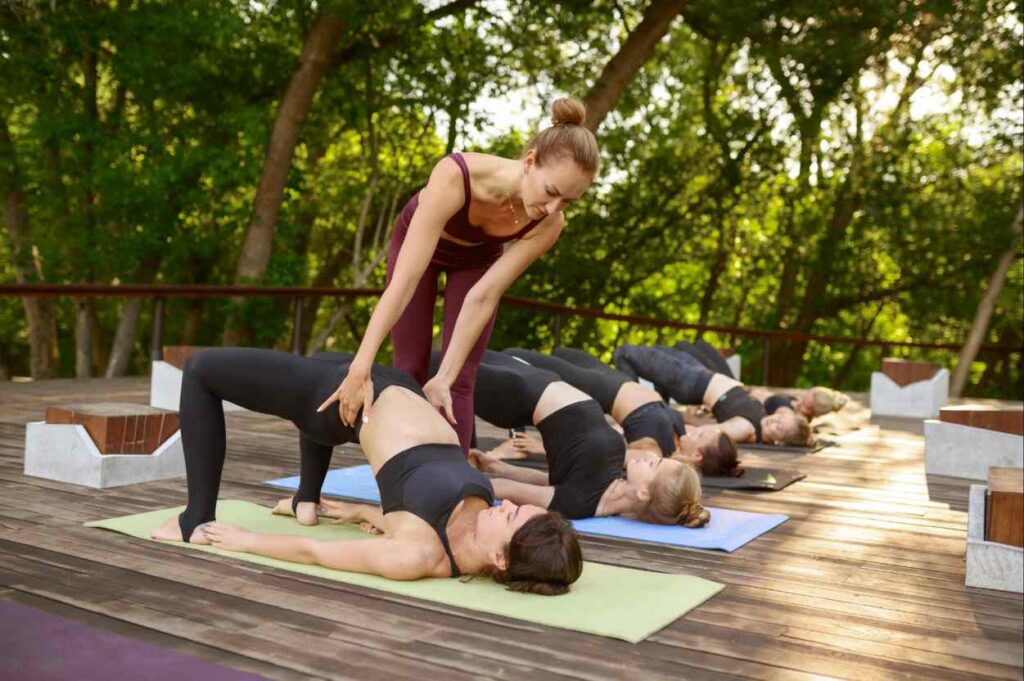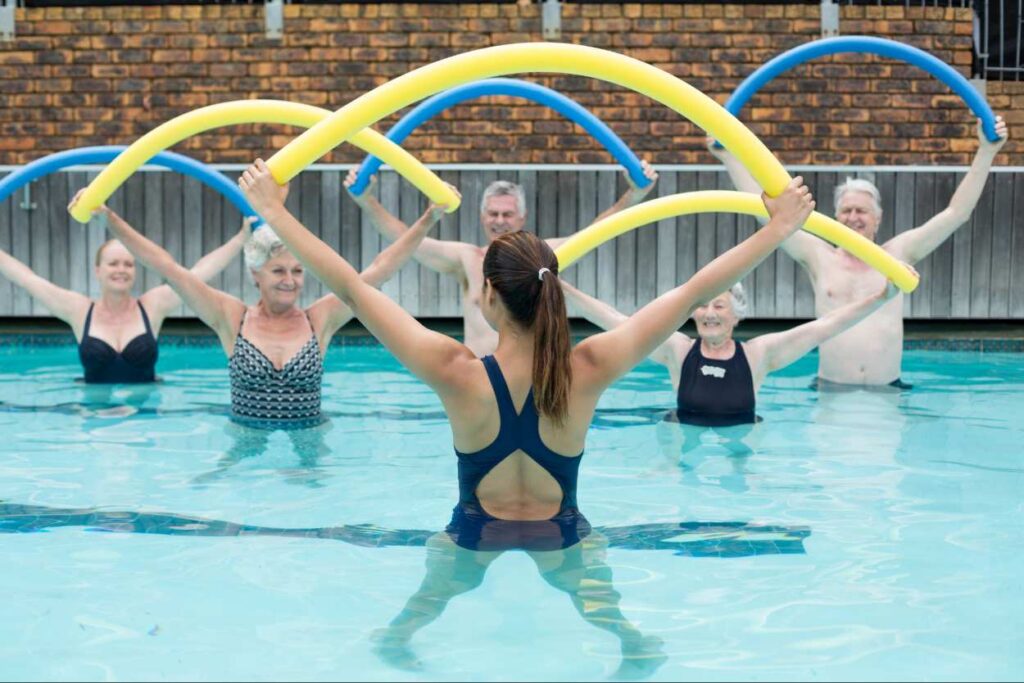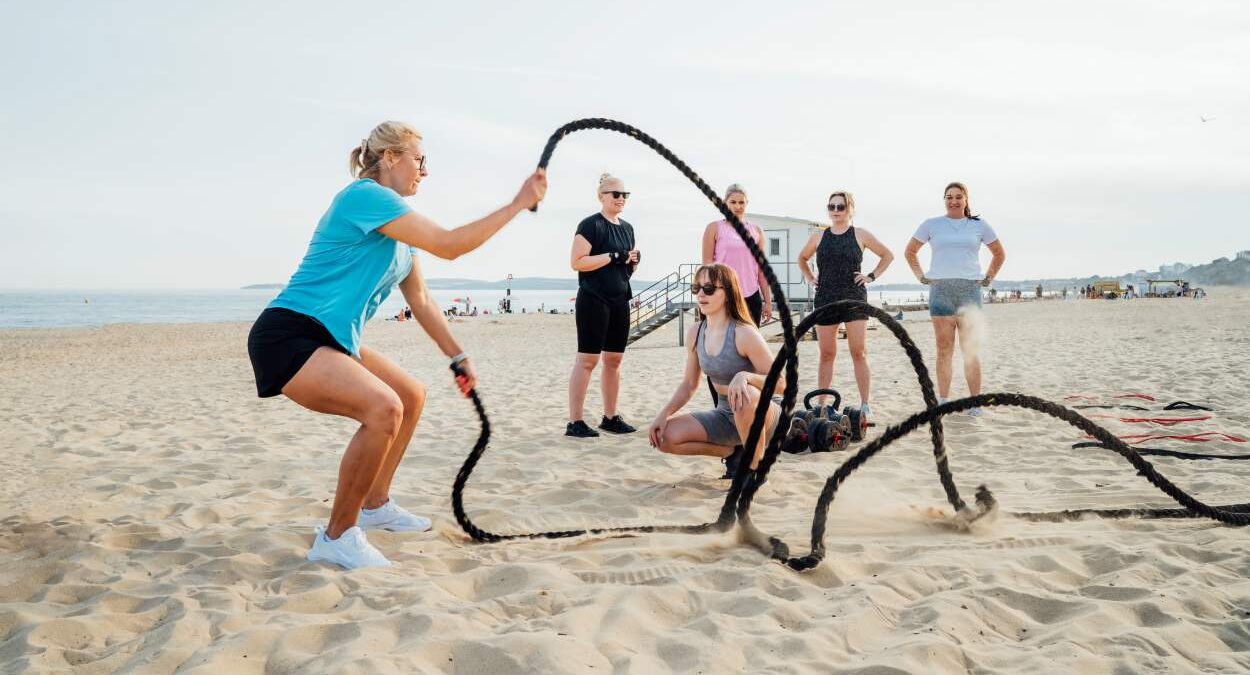Table of contents
Table of contents
If you’re a personal trainer or fitness instructor based in the UK, chances are you’ve thought about taking your skills overseas. Maybe you’ve pictured running bootcamps on the beach in Spain, leading a wellness retreat in Bali, or spending a season with a tour operator in the Med. The good news is – working abroad in fitness isn’t just a dream; with the right planning, it’s a very real and exciting career path.
Demand is being fuelled by the rapid rise of wellness tourism. According to the Global Wellness Institute, the UK’s wellness tourism market grew by 79% between 2020 and 2022, making it one of the fastest-growing segments of the wellness economy. As Ophelia Yeung, Senior Research Fellow at the GWI, explains: “The United Kingdom has one of the world’s largest, most diverse and resilient wellness economies. The British public and its visitors are very sophisticated wellness consumers.” This means more travellers are actively seeking health and fitness as part of their holiday experiences — from high-energy group classes to restorative yoga retreats.
For UK instructors, this demand translates into a wealth of overseas opportunities: from self-employed ventures like running fitness holidays or retreats, to seasonal contracts with resorts and tour operators, to permanent roles in gyms and wellness centres serving expat communities.
This guide covers everything you need to know: where you can work, the roles available, the earning potential, and the practical steps to take your career overseas.
Can you work overseas as a PT or fitness instructor?
In short: yes. Fitness is a global language. Demand for qualified professionals is strong, particularly in destinations where tourism and expat communities drive the fitness market.
Resorts and tour operators often look for instructors to deliver classes and activities that enhance the holiday experience, while expat hubs like Dubai or Singapore have a steady appetite for experienced PTs to serve their year-round communities. Whether it’s running yoga retreats in Bali, teaching HIIT by the pool at a Spanish resort, or coaching expats in a boutique Dubai gym, there are plenty of opportunities for UK instructors to take their career international.
Your UK Level 3 PT qualification is generally well respected abroad, especially if it’s accredited by CIMSPA or REPs. Internationally recognised certifications like NASM, ACE or ISSA can also help open doors. Just make sure you check the local requirements for the country you’re heading to – in some places, you may need to apply for recognition of your qualification or additional licensing.
What to consider before working abroad

Before you pack your trainers and hop on a plane, there are a few important things to weigh up:
Visas and work permits
Different countries have different rules. Some places (like Australia) offer working holiday visas for under 35s, while others require sponsorship from an employer. Always check this before applying.
Recognition of qualifications
Your UK certificates may be enough, but in some countries, you might need to provide proof or apply for local registration.
Money matters
Pay can vary hugely. In Dubai, for example, PTs can earn high tax-free salaries, while seasonal resort work in Europe may be more about the lifestyle than the payslip. Factor in living costs too.
Insurance and safety
Make sure you’ve got fitness instructor liability insurance that covers you internationally and keep health cover in mind too. This is dependent on where you’re a resident. Check if policies have caveats to number of days you can work overseas etc.
How long can you work abroad?
This depends largely on visas, contracts, and what you want from the experience, this breakdown your options:
- Short-term: Seasonal contracts (summer in Greece, ski season in Austria, a stint on a cruise ship). Great if you want adventure without full commitment.
- Medium-term: 1–2-year contracts with gyms, resorts, or corporate wellness providers.
- Long-term: If you fall in love with a country and decide to relocate permanently, you’ll need to explore longer visa routes or residency options.
The beauty of fitness is its flexibility – you can dip in and out of overseas work depending on your goals, provided that you comply with travel rules.
Jobs for fitness instructors overseas
Working abroad doesn’t always mean being a gym-based PT. The opportunities are far broader, ranging from seasonal resort contracts where you’ll be running classes for holidaymakers, to longer-term roles in luxury gyms that cater to expats and locals. Some jobs are designed around the tourist calendar, think summer in Spain or winter on a ski resort, while others offer permanent, stable work in destinations with a strong year-round fitness culture.
Here are some popular options:
- Resort or hotel fitness instructor: Running classes, leading gym sessions, keeping guests active.
- Cruise ship trainer: Travel the world while teaching classes, running workshops, and working with passengers.
- Retreat leader: Deliver yoga, HIIT, or wellness programmes in idyllic locations.
- Local gym or studio PT: Many countries have thriving gym cultures, especially in expat hubs.
- Corporate wellness coach: Companies abroad often invest in staff wellbeing, opening up roles for experienced PTs.
Earning potential for fitness workers overseas

Here’s a ballpark guide to what fitness professionals might expect to earn when working abroad under various arrangements that have been scanned from various job sites.
These figures are indicative and approximate, real income can vary widely depending on your niche, reputation, the resort or gym, cost of living, and extras like accommodation, travel, and perks.
| Country | One-Off / Short Trips (e.g. retreats, guest coaching) | Self-Employed / Freelance | Seasonal / Contract | Permanent / Full-Time Role* |
| Spain | €25–€60 per hour (guest class workshops, retreats) | €30–€70/hr (depending on client base) | €18,000 to €28,000 / year (for 6–9 months) | €24,700 average gross per year (€12/hr) |
| France | €30–€70 per workshop / retreat day | Similar ranges, with chance to charge premium in Paris or affluent areas | €20,000–€35,000 (seasonal resort towns) | €26,300 annual average (range €15,200 to €44,800) |
| Dubai / UAE | AED 300–AED 600+ per session (guest coaching) | High potential if servicing private clients | AED 3,000 – AED 9,000+ / month for employed roles | Many gyms list PT roles in AED 4,000–AED 8,000+ range |
| Thailand | THB 1,500–THB 4,000+ per workshop or retreat day | Freelancers might charge THB 1,000–THB 3,000/hr (in tourist zones) | THB 318,000 to THB 528,000 / year in Bangkok range | THB 440,000 average (THB 318,000–528,000 range) |
| (Extra suggestion) Australia / New Zealand | AUD 80–AUD 150+ per workshop / special event | AUD 50–AUD 120+/hr depending on city / clientele | AUD 40,000 to AUD 70,000 for full year roles in regional resorts or gyms | In major cities, full-time PTs might land AUD 55,000–AUD 80,000+ depending on clientele, commissions, etc. |
* “Permanent / Full-Time Role” often includes benefits such as accommodation, visa sponsorship, travel, or bonuses in resort settings.
Sources: Salary Expert, World Salaries, Naukrigulf, Glassdoor, ERI Economic Research Institute
Fitness programmes you could offer while abroad

Popular examples vary, but being creative with what you offer can really help you stand out, whether you’re applying for structured roles or freelancing on your own.
- Beach bootcamps – HIIT in the sand, sunrise circuits, or beach yoga.
- Adventure fitness – hiking, paddleboarding, or outdoor conditioning linked to the destination.
- Wellness programmes – meditation, mobility, or recovery-focused sessions for retreats.
- Tourist-friendly classes – fun, accessible group workouts for travellers on short breaks.
- Hybrid coaching – offering online PT to UK clients alongside in-person work abroad.
Other ways to work overseas in fitness
You don’t have to go it alone. Tour operators like TUI and Neilson often recruit fitness staff for their resorts, offering a structured way to live and work abroad. There are also opportunities in adventure tourism – think trekking guides, surf instructors, or wellness coordinators.
If you’ve got a taste for independence, you could also combine travel with remote PT services, becoming a kind of fitness “digital nomad”. Although living this way, you may find difficult to get the insurance you need to protect yourself.
Best destinations to work for fitness instructors
Some destinations are especially popular with UK instructors:
- Europe (Spain, Greece, Portugal, Cyprus): Resorts and hotels, perfect for seasonal contracts.
- Middle East (Dubai, Abu Dhabi, Qatar): High demand, high salaries, and luxury gyms – though competition can be fierce.
- Asia (Thailand, Bali, India): Yoga, retreats, and wellness-focused opportunities.
- Australia & New Zealand: Strong fitness culture, lots of gyms, and working holiday visa options for under 30s.
- Cruise ships: A brilliant way to travel to multiple continents while working.
Tips for landing a PT job overseas
- Use international job boards (LeisureJobs, GymJobs, Cruise Ship recruitment agencies).
- Network with other trainers online – LinkedIn and Instagram are powerful tools.
- Offer
- Be flexible: Sometimes the best opportunities come from being open to different roles or locations.
Final thoughts…
Working abroad as a fitness instructor can be one of the most rewarding adventures you’ll ever take. Whether it’s a summer season in Europe, a year in Dubai, or a new life in Australia, the skills you’ve built in the UK are highly transferable.
It’s not just about earning money – it’s about the experiences, the people you’ll meet, and the chance to grow both personally and professionally. If you’ve been thinking about it, there’s no better time to start exploring opportunities.
Find the best Fitness Instructor Insurance with Protectivity
If you’re planning to take your skills abroad, the first thing to check is if your qualification allows you to work abroad, the second that your fitness instructors insurance goes with you. Adding an Overseas Extension, you can work abroad for up to 30 days a year, choosing between Europe or Worldwide cover (excluding the USA) – ideal for leading retreats, taking on seasonal roles, or working with expat clients.
Protectivity’s insurance offers Public Liability and Professional Indemnity insurance provide up to £10 million of protection against claims if a client or third party is injured, or if someone alleges, they’ve suffered loss from the advice you’ve given. Your equipment is also safeguarded, with £500 worth of cover included as standard and the option to extend up to £30,000, ensuring the tools you rely on are protected from loss, damage, or theft. For extra confidence, you can add Personal Accident Cover, which supports you financially if you’re injured while delivering fitness services, helping you stay secure while you recover.
Get a quote for fitness Instructor Insurance that gives you the confidence to focus on creating unforgettable fitness experiences.
Fitness Instructor Insurance

*Disclaimer – This blog has been created as general information and should not be taken as advice. Make sure you have the correct level of insurance for your requirements and always review policy documentation. Information is factually accurate at the time of publishing but may have become out of date.
Last updated by

















